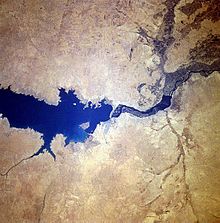Water management in Greater Damascus
The quality of residential water supply mirrors social divisions within the metropolitan area, with the poorest neighborhoods receiving the worst service.
Irrigation in the rural parts of Greater Damascus, in particular in the Ghouta, still accounts for about 70% of water use in the metropolitan area, with the remainder being used for residential, commercial and industrial use.
The government has responded to the above challenges by banning the drilling of new agricultural wells, promoting water-saving irrigation techniques, rehabilitating the distribution network to reduce leakage, investing heavily in wastewater treatment for reuse, and experimenting with groundwater recharge.
Reallocation of water from irrigation to urban uses has also been suggested, but it has never been seriously considered by the government for political reasons, including strong traditional links of the ruling Baath Party to the Peasant's Union.
Instead of forcefully promoting local solutions, the government continues to contemplate the large-scale transfer of water from Lake Assad on the Euphrates River through a costly mega-project.
The flow of the springs is highly seasonal, lagging several months behind the precipitation because of snow melt and the karstic characteristics of the rocks from which they emerge.
Some winter flows also end up in the intermittent Lake Al-Utaybah, the lowest point of the closed Barada basin where the water infiltrates or evaporates.
[1] The lower bound of this estimate is probably more realistic and is equivalent to an average of about 220 liter/capita/day before distribution losses for a population connected to the network of about 3.75 million.
According to a 2009 article by US political scientist Jessica Barnes, while water scarcity in Syria is usually presented as a result of population growth, it actually is a consequence of the ruling Ba'ath party’s promotion of water-intensive agriculture.
[3] This political context may explain why the government is reluctant to take drastic steps to reduce the pumping of groundwater from private wells for irrigation in the Ghouta near Damascus.
[4] The foremost water challenge in Greater Damascus is an increasing demand-supply imbalance, coupled with groundwater overexploitation and pollution.
This imbalance leads to intermittent supply and coping costs in the form of expensive sales of water by tankers.
After a land reform in 1958 newly created cooperatives were unable to maintain the irrigation canals and to implement the distribution system.
Surface and groundwater in the Barada basin is polluted by industrial and domestic wastewater, as well as by agricultural non-point sources such as fertilizers and pesticides.
Much of the wastewater generated from industrial activities in Greater Damascus is discharged into the environment, mainly to the Barada River, without prior treatment.
The uncontrolled disposal of toxic, chemical products, primarily from lead industries and battery manufactories, has also resulted in severe soil pollution.
Due to pressure changes when supply is turned on and off, pollutants are sucked into leaky distribution pipes which further contaminates drinking water.
As a result of the rebel capture of the village of Ain al-Fijah in the Barada River valley and its water spring in February 2012, the flow of water to Damascus and nearby towns has been sporadically cut off by the rebels in retaliation for military operations by government forces in the region for almost 5 years.
As a result, running water was cut off to more than 5.5 million people around Damascus and the government forces launched an offensive on rebel-held villages in the Barada River Valley.
In 2006 the government has temporary revived plans for an expensive scheme to bring in water from the Euphrates river, located more than 400 km from Damascus.
In 2006, the authorities were forced to stop the implementation of a plan for the drilling of more than 200 wells for drinking water supply in several regions of the Ghouta, as nitrate concentrations from the excessive use of fertilizers and from untreated wastewater seeping into the ground were found in the range of 100-200 mg/L (the drinking water quality standard sets a limit of 40 mg/L).
In 2004, JICA completed a US$50m eight-year project to replace 100 km of water pipes across Damascus, which it said resulted “in a dramatic reduction in loss of water through pipe leakage from some 60 percent to 20 percent” in the sections covered [7] However, the level of leakage remained high in other sections of the network.
[12] The government plans to build a total of 30 wastewater treatment plants throughout Greater Damascus, including in towns in the Barada gorge.
[8] The European Investment Bank is financing the construction of four wastewater treatment plants to serve more than 400,000 inhabitants in the Southwest of Damascus.
The government plans to transfer some of this water through the existing pipelines, chlorinate it and inject it through recharge wells into the aquifer below Damascus to store it for use during summer.
The Syrian government has at various times considered two alternative mega-projects to bring additional water to the Greater Damascus area.
One plan consisted in the transfer of water from the coastal region over a distance of at least 225 km and a cumulated difference in altitude of about 1000m.
The water sources considered were two reservoirs in the coastal basin and even offshore springs in the Mediterranean or desalination of seawater at a total cost of more than US$1 per cubic meter including its transfer.
In 2006 Syrian officials said they were “pressing ahead” with a feasibility study by a Swiss company to transfer water from the Euphrates to Damascus at an estimated cost of US$2 billion.
Arab Center for the Studies of Arid Zones and Dry Lands (ACSAD) and the German Federal Institute for Geosciences and Natural Resources (BGR):Cooperation project "Management, Protection and Sustainable Use of Groundwater and Soil Resources in the Arab Region":Pilot Project in the Damascus Ghouta



